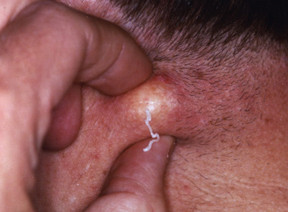Sebaceous cysts
- Reviewed by Howard E. LeWine, MD, Chief Medical Editor, Harvard Health Publishing; Editorial Advisory Board Member, Harvard Health Publishing
What is a sebaceous cyst?
Sebaceous cysts are small lumps that arise within the skin on the face, neck, upper back and upper chest. A sebaceous cyst can form when the opening to a sebaceous gland becomes blocked. The oily substance called sebum continues to be produced but cannot escape to the outer skin surface.
|
|
The cyst may remain small for years, or it may continue to get larger. These cysts are rare in children but common in adults. Sebaceous cysts are not cancerous.
Symptoms of a sebaceous cyst
A cyst is a movable, dome-shaped, smooth-surfaced mass that varies in size from a few millimeters to several centimeters (from less than a quarter of an inch to more than 2 inches). Sebaceous cysts appear primarily on the face, upper back and upper chest.
Diagnosing a sebaceous cyst
Your doctor can examine the swelling and tell you if you have a cyst.
Expected duration of a sebaceous cyst
A cyst may disappear on its own or remain indefinitely.
Preventing a sebaceous cyst
Sebaceous cysts that occur in people with acne can be prevented by keeping acne under control with medication.
Treating a sebaceous cyst
A sebaceous cyst usually does not need to be treated unless it is inflamed (red) or is causing a cosmetic problem. Inflamed cysts usually are treated by draining the fluid and removing the shell that make up the cyst wall. You also may be treated with antibiotics if the skin around the cyst is infected. If a cyst is causing irritation or cosmetic difficulty, your physician can remove it by making a small incision in the skin and emptying the contents of the cyst and its wall.
When to call a professional
If you have a new swelling on your skin that lasts for more than two weeks, contact your doctor, especially if it is painful.
Prognosis
The outlook for sebaceous cysts is excellent. Many cysts have no symptoms and some will go away on their own. Cysts can return. If your cyst is problematic, your doctor may decide to drain it or remove it surgically. This does not usually lead to any complications or side effects.
Additional info
American Academy of Dermatology
https://www.aad.org/
About the Reviewer

Howard E. LeWine, MD, Chief Medical Editor, Harvard Health Publishing; Editorial Advisory Board Member, Harvard Health Publishing
Disclaimer:
As a service to our readers, Harvard Health Publishing provides access to our library of archived content. Please note the date of last review or update on all articles.
No content on this site, regardless of date, should ever be used as a substitute for direct medical advice from your doctor or other qualified clinician.













